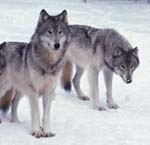 As a vegetarian, pet-owning urbanite who’s never been hunting, I find it hard to stomach the idea of grown men with rifles killing fuzzy baby animals. So it was with mixed feelings I read today that Alaskan tribes will have to wait until November to see if they can legally cull wolf pups and bear cubs in their dens along the Kuskokwim River. The now-banned practice, traditional among Orutsaramuit people in southwestern Alaska, is intended to reduce predators killing too many of the moose that tribes rely on for subsistence hunting. While conservationists predictably see the practice as cruel, the real bone of contention lies between the state of Alaska and tribal officials.
As a vegetarian, pet-owning urbanite who’s never been hunting, I find it hard to stomach the idea of grown men with rifles killing fuzzy baby animals. So it was with mixed feelings I read today that Alaskan tribes will have to wait until November to see if they can legally cull wolf pups and bear cubs in their dens along the Kuskokwim River. The now-banned practice, traditional among Orutsaramuit people in southwestern Alaska, is intended to reduce predators killing too many of the moose that tribes rely on for subsistence hunting. While conservationists predictably see the practice as cruel, the real bone of contention lies between the state of Alaska and tribal officials.
The state of Alaska says that the moose population actually increased from 2004 to 2006, years during which at least 70 wolves were killed in reduction efforts. Another estimate, from May 2007, also showed that the moose population in the tribe’s area is on the rise.
A natural resources representative from the Orutsaramuit Native Council disagrees. He says the area in contention “was the best moose habitat in the country and it’s almost totally gone now…We want to do everything we can to get moose numbers up back to the way they were.”
Unfortunately, the Native Council has not supplied any hard numbers (as far as I could see) on moose populations. So what’s the state of Alaska to do—trust anecdotal evidence that moose are nearly gone and allow native Alaskans to reduce wolf and bear populations, or trust its own data that there are plenty of moose around—and risk alienating a local tribe? What’s your take?















